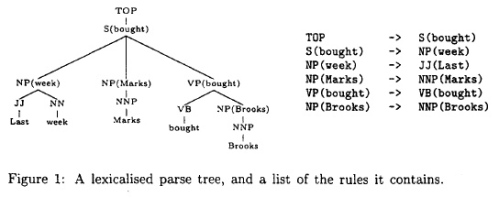Parsing is making a syntactic analysis. A sequence of tokens is analyzed by means of a hierarchical structure, such as a parse tree.

In some translation systems parsing is done by computer programs. It is not easy to translate sentences, because of the ambiguities of the human language; so as to create a parsing system, experts have to take into account all the gramatic posibilities. As a machine is not able to translate with total fidelity, the system used in translators and parsers is based on statistics, which are created by human language investigators who work on specific contexts.
The most common use of parsers is as a component of a compiler or interpreter, and their language memory is based on a context-free grammar because it is easier to work with sentences seeing them out of any specific context. In the book ‘Parsing Techniques: a practical guide’ another important use of parsers is described: ” contribute to all existing software: they enable Web browsers to analyze HTML pages and PostScript printers to analyze PostScript, and some of the more advanced techniques are used in code generation in compilers and in data compression. Also their importance as general pattern recognizers is slowly being acknowledged“.
In the dept. of Computer and Information Science in the University of Pennsylvania, Michael Collins has proposed three new parsing models:
- MODEL 1: it is an improvement on the usual parsing models created by now.
- MODEL 2: the parser is extended to make the complement/adjunt distinction. This is done by the addition of probabilities over subcategorisation frames for head-words.
- MODEL 3: a probalilistis treatment of wh-movement is given, and it consists of a derivation of the analysis in ‘Generalized Phrase Structure Grammar’.
REFERENCES
-Parsing. (2009, April 7). In Wikipedia, The Free Encyclopedia. Retrieved 16:55, April 9, 2009, from http://en.wikipedia.org/w/index.php?title=Parsing&oldid=296074492
– ‘Three Generative, Lexicalised models for Statistical Parsing’ by Michael Collins, dept. of Computer and Information Science, University of Pennsylvania, Philadelphia, USA. Retrieved 18:22, April 9, 2009, from http://www.aclweb.org/anthology-new/P/P97/P97-1003.pdf
– Diazdesantos.es on ‘Parsing techniques: a practical guide’ . Retrieved 17:33, April 9, 2009, from http://www.diazdesantos.es/libros/grune-dick-parsing-techniques-a-practical-guide-L0490401119111.html
– ‘Parsing techniques: a practical guide’ (2008, February 1) by Dick Grune. Retrieved 17:40, April 9 , 2009, from http://books.google.es/books?hl=es&lr=&id=05xA_d5dSwAC&oi=fnd&pg=PR5&dq=%27Parsing+techniques:+a+practical+guide%27&ots=3MuxaHl6L9&sig=t9UqCX42lglNF-KRIxY6Q_R_dug
